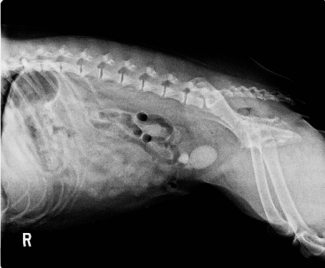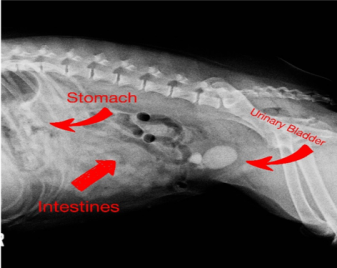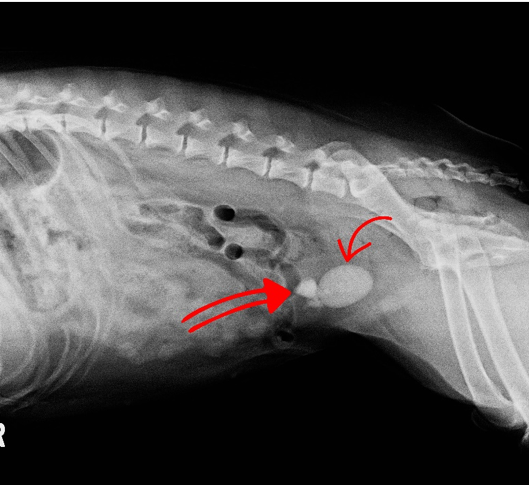February Case of the Month

 Lucy, a 4-year-old female spayed Labrador Mix, presented to Stagecoach Pet Hospital for frequent urination.
Lucy, a 4-year-old female spayed Labrador Mix, presented to Stagecoach Pet Hospital for frequent urination.
Her owner noticed that her urine was darker than usual.
Physical Exam:
Lucy has a normal body temperature as well as heart rate and respiration. During the examination, Lucy urinated and it was blood- tinged. No other significant problems were noted on examination.
Diagnostics:
Lucy had an x-ray of her belly performed. In this x-ray, Lucy is laying on her side with her head facing to the left (head not pictured). See below.


Can you spot something abnormal in the urinary bladder?
Below you can see arrows pointing to several large bladder stones! OUCH!

A urine sample was then analyzed and a urinary tract infection was found.
Treatment:
Due to the large number of bladder stones, the doctor recommended bladder surgery to have them removed. Lucy was also started on antibiotics and pain medication.
Lucy's procedure went well and there were no complications removing the bladder stones. The stones were sent to an outside laboratory for analysis. They were found to be triple phosphate (Struvite) stones. Lucy's parents have reported that she feels better than ever now that she is no longer having repeat urinary infections and bladder pain!
How did the stones form?
"Struvite is the name given to the crystal composed of magnesium, ammonium, and phosphate. Struvite crystals are not unusual in normal urine and their presence alone does not require treatment. Combine them with certain bacteria, however, and a stone is created.
Stone creation is made possible by an enzyme called urease that certain bacteria, particularly Staphylococci and Proteus species, can produce. Urea is a substance seen in large amounts in urine. Where does all this urea come from? In short, when the body breaks down amino acids, it must contend with ammonium that is generated in this process. The ammonium, which would be toxic if left alone, is converted to urea, which is much less toxic and is readily soluble in water making for its easy disposal in urine. Unfortunately, adding urease-positive bacteria into the urinary bladder converts the urea back into ammonium. The combination of infection and inflammation caused by the ammonium creates a matrix which traps the struvite crystals and gels into an actual stone. This reaction can only take place in an alkaline urine but the ammonium creates the perfect pH for stone formation. In dogs, the general rule is: No infection, no struvite bladder stone."
- Wendy Brooks, DVM, DABVP
Lucy will have her urine monitored closely for the next several months in order to prevent more infections.
If you suspect your pet has a urinary infection (trouble urinating, change in urine color, increased urination) please call and schedule an appointment as soon as possible.
Let us know you read our case of the month and receive a free nail trim!

